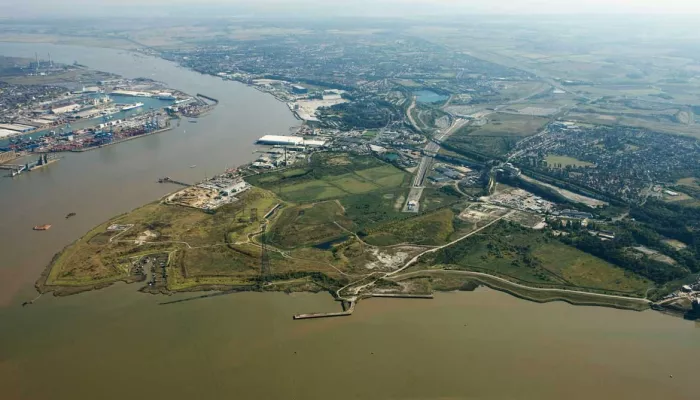Kent Wildlife Trust is concerned that proposals for the London Resort theme park are contrary to the Government’s commitments to create a Nature Recovery Network, to protect 30% of the UK for wildlife by 2030, and would set an alarming precedent for the destruction of designated habitats.
Kent Wildlife Trust, Buglife, the RSPB and CPRE Kent have come together to save one of Kent’s most important wildlife sites, home to the scarce brown-banded carder bee, the critically endangered Distinguished Jumping Spider, and Rare Man Orchid.
The four organisations are urging the Government’s adviser on the natural environment Natural England to swiftly confirm Swanscombe Peninsula as a Site of Special Scientific Interest (SSSI) following the close of the public consultation yesterday, July 12th.
The Swanscombe Peninsula was notified as a SSSI in March, however, it will not get full legal protection until the site is officially confirmed.
Julia Hunt, Head of Advocacy at Kent Wildlife Trust said: “Government is clear on its ambitions for nature. But it needs to turn words into action and step up to prevent our best sites being lost to development. If it does not protect places like the Swanscombe Peninsula it will be failing in its ambitions to make the UK a nature rich nation and failing people who need nature. Wildlife needs these places, and people, particularly in urban areas, need these places.”
Craig Macadam, Director of Conservation at Buglife said: “Recent surveys have revealed that the Swanscombe Peninsula is home to more rare and threatened species than any other site in England of any type. It is a truly special place which is why it was notified as a SSSI by the Government earlier this year. However the site could be lost if plans to build the new London Resort theme park are approved, so we really need the notification swiftly confirmed and the site afforded full legal protection.”
Swanscombe Peninsula is home to over 250 rare and threatened invertebrate species, including the critically endangered distinguished jumping spider, the endangered Duffey’s bell-head spider, brown-banded carder bee, saltmarsh shortspur beetle and the orange-striped water beetle. The site is also home to rare plants such as the man orchid and an outstanding diversity of breeding birds including nightingales, cuckoos, and the elusive grasshopper warbler, as well as bats, reptiles and water voles.
Nick Bruce-White, RSPB Operations Director, Southern England at RSPB said: "This theme park must not take precedence over the species and habitats that it threatens; the developers must withdraw their application. We also find it inappropriate that a theme park has been deemed a “Nationally Significant Infrastructure Project”, a status normally reserved for major roads, airports or power plants, that may allow it to bypass many of the normal planning requirements.
“If the SSSI is confirmed, and the development is still consented, it will be one of the largest ever single losses of nationally protected habitat in UK, including the direct loss of over 100ha of SSSI land. We cannot allow this to happen; that's why we're calling on the Government to confirm the designation as soon as possible.”
Campaigners claim that the proposals are contrary to the Government’s commitments to create a Nature Recovery Network (NRN) and to protect 30% of the UK for wildlife by 2030, and would set an alarming precedent for the destruction of designated habitats.
The campaign is asking people to support the ‘Save Swanscombe Marshes’ campaign by adding their names to the 24,682 people who have already signed the petition to protect the site - you can sign the petition here.
More information
- SSSIs are designated because they support wildlife and wild places of national importance. They represent our best sites for wildlife. By area, well over half are internationally important and many play an important part in local culture and economies or provide wonderful opportunities for people to enjoy wildlife and the landscape. The natural wildlife and geological features of SSSI’s are irreplaceable parts of our national heritage.
- The purpose of SSSIs is to safeguard the diversity of wildlife and nature rich landscapes for present and future generations. Where Natural England is of the opinion that land is of special interest by reason of its flora, fauna, or geological or physiographical features, it is the duty of Natural England to designate an SSSI.
- A proposal for the London Resort theme park development across the area will cause significant, permanent damage to nationally and internationally important wildlife and habitats.
- The Swanscombe Peninsula supports a nationally important assemblage of terrestrial invertebrates, populations of aquatic invertebrates of high conservation value, and a nationally significant population of the Tentacled lagoon-worm (Alkmaria romijni), the habitat of which is protected under the Wildlife & Countryside Act (WCA) (1981). In total there are over 250 invertebrate species of conservation concern, and 50 red listed species, including the Critically Endangered Distinguished jumping spider (Attulus distinguendus). It also supports a regionally important breeding bird assemblage including 15 red-listed Birds of Conservation Concern and 12 Species of Principal Importance, 13 nationally scarce vascular plant species, including 5 red-listed species, and populations of reptiles, bats, Water vole (Arvicola amphibious) and Otter (Lutra lutra). The overall value and uniqueness of the site with its mosaic of habitats is demonstrated by the sheer taxonomic breadth of the species of conservation concern.
- Read Natural England’s blog on the importance of the Swanscombe Peninsula here.
- A public consultation on the SSSI designation ran until 12th July. Natural England consultation here.

